Bulletin – December 2013 Global Economy Foreign Currency Exposure and Hedging in Australia
- Download the article 416KB
Abstract
The 2013 Australian Bureau of Statistics (ABS) Foreign Currency Exposure survey confirms that Australian entities' financial asset and liability positions remain well hedged against a depreciation of the Australian dollar, either through the use of foreign currency hedging derivatives or through offsetting foreign currency asset and liability positions. Even before taking into account the use of hedging derivatives, Australian entities as a whole have a net foreign currency asset position with the rest of the world. After accounting for hedging derivatives, this overall net foreign currency asset position increases slightly. This is primarily because the banking sector hedges all of its net foreign currency liability exposure, although this is partly offset by other financial corporations hedging part of their overall net foreign currency asset exposure. As a result of this net foreign currency asset position, the Australian economy's net overall foreign liability position would not in itself be a source of vulnerability in the event of a sudden depreciation of the Australian dollar.
Introduction
Since the float of the Australian dollar 30 years ago, Australia's flexible exchange rate has played an important role in cushioning the economy from external shocks and smoothing fluctuations in the business cycle.[1] Yet for individual entities with foreign currency assets, liabilities or trade exposures, fluctuations in the exchange rate can lead to changes in the Australian dollar value of their balance sheet positions and cash flows. Depending on the distribution of these foreign currency exposures across individual sectors, there could be flow-on effects for financial stability and the real economy. It is therefore important to understand how these foreign currency exposures are distributed throughout the economy and the extent to which they are hedged.
In terms of balance sheet exposures, Australian entities have traditionally had an overall net liability position with the rest of the world. This net foreign liability position reflects ongoing capital inflows – which are the counterpart to sustained current account deficits – and has fluctuated between 55 and 60 per cent of GDP for a number of years.[2] While the size of this liability position could potentially be a cause for concern, the majority of Australian entities' foreign liabilities are denominated in Australian dollars, whereas most foreign assets are denominated in foreign currencies. As a result, Australia has consistently had a net foreign currency asset position, with the net overall liability position reflecting liabilities that are denominated in Australian dollars.
This net foreign currency asset position means that a depreciation of the Australian dollar reduces the size of Australian entities' overall net foreign liability position by increasing the Australian dollar value of foreign currency assets relative to foreign currency liabilities (the converse is true for an appreciation). This is true even before any hedging of these foreign currency positions is taken into account.
Notwithstanding the net foreign currency asset position for the economy as a whole, some individual entities – particularly in the banking sector – have net foreign currency liability positions. Unless these firms' net foreign currency liabilities are hedged, a depreciation of the Australian dollar could result in a deterioration of their balance sheet positions – by increasing the Australian dollar value of their liabilities relative to their assets.
In addition, as nearly 80 per cent of Australian merchandise trade is denominated in foreign currency, movements in the exchange rate can also affect the cash flows of trade-exposed firms by altering the Australian dollar value of their trade payments and receipts. Australian dollar depreciation will tend to reduce profits for net importers, while supporting the profitability of net exporters and import-competing firms – and vice versa for an appreciation – unless these foreign currency exposures are hedged.
In view of this, the Reserve Bank initiated and has provided funding for the ABS to undertake a survey of firms' foreign currency exposures – and their use of foreign currency derivatives to hedge these exposures – every four years since 2001. The most recent survey of Foreign Currency Exposure (FCE) was conducted as at the end of March 2013.[3] Compared with previous surveys, the 2013 results include more direct information about respondents' use of derivatives for hedging purposes, particularly for foreign currency debt security liabilities. However, owing to data limitations, the 2013 survey contains less information than previous surveys on the extent to which firms hedge their expected trade payments and receipts. As a result, the remainder of this article focuses on the hedging of balance sheet exposures only.[4]
It should also be noted that while the FCE survey quantifies the extent to which derivatives are used to hedge foreign currency risk, it does not directly account for ‘natural hedges’. Natural hedges are created by payment obligations and/or receipts that have at least partially offsetting foreign currency risk; for example, a bank's use of a US dollar deposit to fund the purchase of an interest-bearing US dollar asset, or a superannuation fund's investment in a foreign currency asset that has a price that tends to be negatively correlated with movements in the relevant exchange rate. While the survey indirectly accounts for natural hedges that are created by netting foreign currency asset and liability positions against each other, no account is taken of other forms of natural hedging, such as those that are based on historical relationships between exchange rate movements and the foreign currency price of the underlying exposures.[5]
Aggregate Results
As at the end of March 2013, international investment position (IIP) data indicated that Australian entities overall had a net foreign currency asset position equivalent to 27 per cent of GDP before taking into account the use of derivatives for hedging purposes (ABS 2013a).[6] This is because most foreign liabilities are denominated in Australian dollars while most foreign assets are denominated in foreign currencies (Graph 1). This net foreign currency asset position before hedging has increased from 7 per cent of GDP from the end of March 2009, driven by a decline in the value of foreign currency denominated liabilities. This in turn reflected a compositional shift towards equity liabilities (which are denominated almost entirely in Australian dollars) and away from debt liabilities (some of which are denominated in foreign currencies).
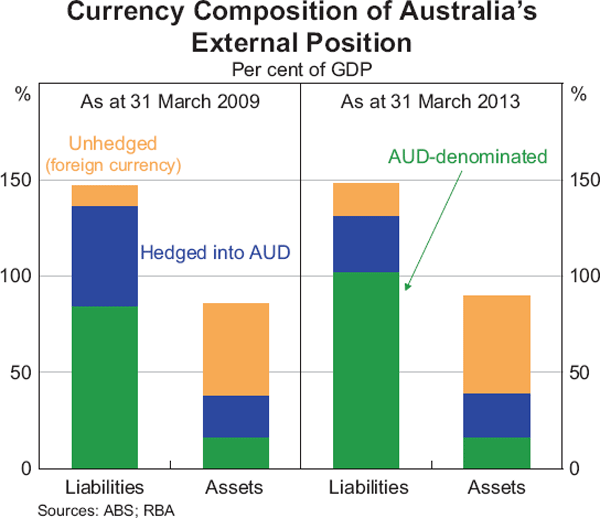
About 70 per cent of foreign liabilities were denominated in Australian dollars as at the end of March 2013 – equivalent to about 100 per cent of GDP. Within this, equity liabilities equated to around 50 per cent of GDP, while the banking sector's Australian dollar-denominated foreign debt liabilities and foreign holdings of Commonwealth Government securities (CGS) were each equivalent to a little less than 15 per cent of GDP. In contrast, 80 per cent of Australian entities' foreign assets were denominated in foreign currencies – or the equivalent of around 75 per cent of GDP.[7] Within this, foreign equity investments and foreign currency denominated debt assets equated to around 45 per cent and 30 per cent of GDP, respectively.
Information from the latest FCE survey indicates that, after accounting for derivatives used to hedge foreign currency exposures, Australia's effective net foreign currency asset position was equivalent to a little more than 30 per cent of GDP as at the end of March 2013. This is because a greater share of foreign currency liabilities were hedged compared with foreign currency assets (with hedging ratios of around 60 per cent and around 30 per cent, respectively).[8] The higher overall net foreign currency asset position after hedging primarily reflects the fact that, in aggregate, the banking sector reported that it hedged virtually all of its net foreign currency liability position using derivatives. For other sectors – discussed in more detail below – hedging via derivatives was reported to reduce the foreign currency asset position of ‘other financial’ corporations, but to increase the foreign currency asset position of private non-financial firms (which are referred to as ‘other residents’ in the FCE survey) a little.
Debt securities account for a bit more than two-thirds of Australia's foreign currency debt liabilities. In recognition of this, the 2013 FCE survey collected additional data on foreign currency denominated debt security liabilities, the use of foreign currency derivatives to hedge these and the extent to which the maturity of these hedges are matched to the maturities of underlying exposures. With complete hedging, maturity matching ensures that an entity will not be exposed to foreign currency risk for the entire duration of the underlying exposure and can avoid rollover risk that might otherwise be associated with maintaining its hedges. These data indicate that, in aggregate, around 80 per cent of the value of foreign currency denominated debt security liabilities were hedged using derivatives, reflecting a hedging ratio of 84 per cent for short-term debt liabilities and 77 per cent for long-term debt securities, on a residual maturity basis (Graph 2).[9] Also, around 95 per cent of these foreign currency derivative hedges were maturity matched.
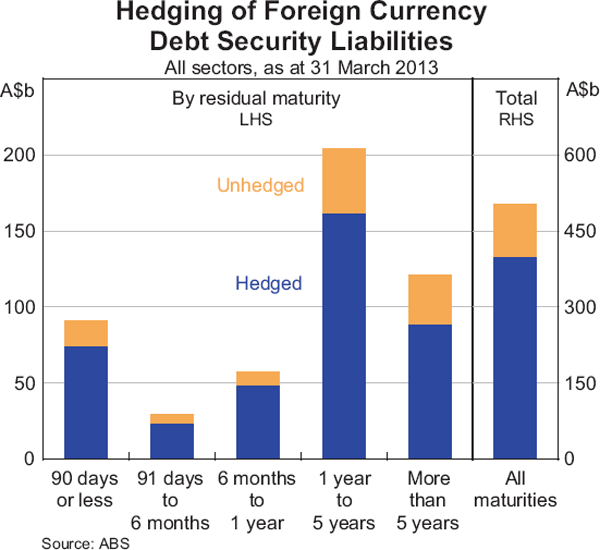
‘Other’ debt liabilities, which consist primarily of loans and deposits, account for the remaining one-third of Australia's gross foreign currency debt liability exposures. The FCE survey indicates that around a quarter of these other debt liabilities were hedged using derivatives as at the end of March 2013. This relatively low derivatives-based hedging ratio may reflect the prevalence of natural hedging for other debt liabilities – in particular, through offsetting foreign currency asset positions. For the Australian economy as a whole, the FCE survey reveals that holdings of other foreign debt assets largely offset other foreign debt liabilities across a range of currencies (Graph 3). This feature is also evident across individual sectors.
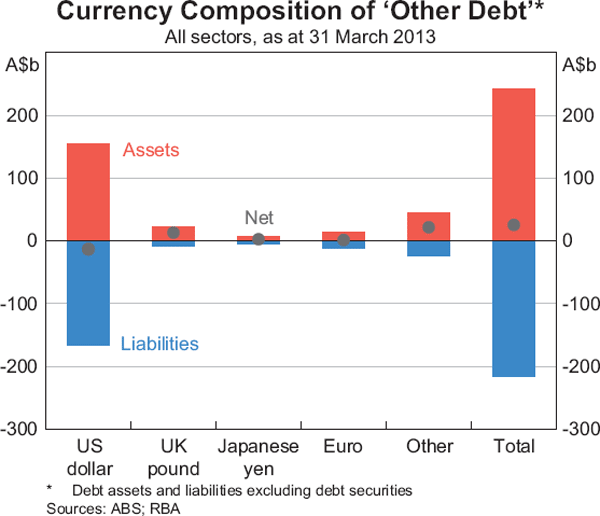
Further to providing information about the nature of Australian entities' foreign currency exposures, the FCE survey also contains detailed information on the notional amount of foreign currency derivative holdings as at the end of March 2013. Consistent with the finding that the use of derivatives increases the effective size of the Australian economy's net foreign currency asset position, the survey reveals that Australian entities had a net long foreign currency derivative position vis-à-vis non-residents (Graph 4).[10] In addition to derivatives used for hedging purposes, this notional amount includes foreign currency derivatives used for other purposes, such as trading derivative positions which are held for the purpose of gaining exposure to particular foreign currency markets. Non-resident counterparties to Australian residents' long foreign currency derivative positions include foreign entities that issue Australian dollar bonds in the domestic market (known as Kangaroo bonds). To the extent that Kangaroo bond issuers seek to hedge their Australian dollar liabilities, they are natural counterparties for Australian entities wishing to hedge their foreign currency debt liabilities (Arsov et al 2013). In addition, a sizeable share of non-resident counterparties are foreign investors seeking to gain (rather than hedge) Australian dollar exposure via derivative markets.
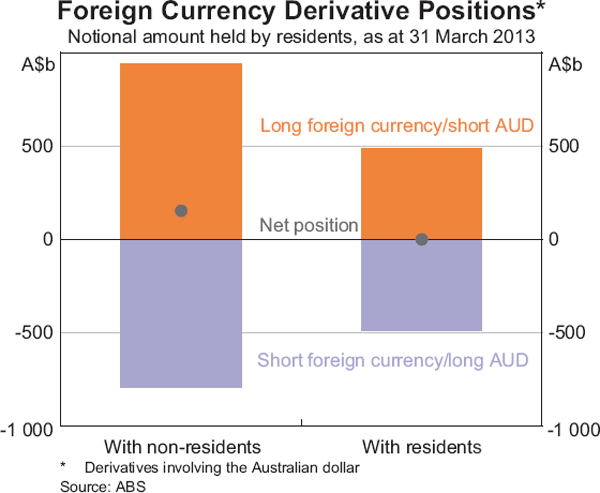
By type of instrument, cross-currency swaps accounted for around two-thirds of the total notional amount of long foreign currency derivative positions and close to half of short foreign currency derivative positions.[11] This represents a substantial increase in the use of cross-currency swaps since the 2009 FCE survey. At that time, these instruments accounted for around 40 and 30 per cent of long and short foreign currency derivative contracts, respectively, with foreign exchange forward contracts being the dominant instrument. The increased use of cross-currency basis swaps is attributable to the banking sector and is consistent with a lengthening in the average maturity of banks' new offshore wholesale funding over the 2009–2013 period. Arsov et al (2013) explain that cross-currency swaps are better suited to hedging longer-term foreign currency risk compared with forward contracts, which are generally used to hedge shorter maturities.
Sectoral Results
The sectoral results for the 2013 survey indicate that Australia's aggregate net foreign currency asset position was held principally by non-bank private financial corporations (other financial corporations), with non-financial corporations and the public sector (including the Future Fund and the Reserve Bank) also holding small net foreign currency asset exposures (Graph 5). In contrast, the banking sector had a net foreign currency liability position before taking into account the use of derivatives for hedging purposes and a net foreign currency asset position of close to zero after accounting for the use of hedging derivatives.
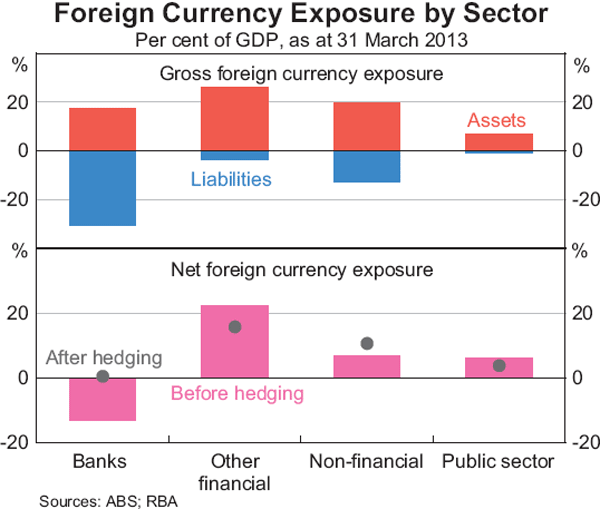
Banks
The 2013 FCE survey shows that, before taking account of the use of hedging derivatives, the banking sector had a net foreign currency liability position equivalent to 13 per cent of GDP, reflecting a foreign currency asset position of 18 per cent of GDP and a foreign currency liability position of 31 per cent of GDP (Table 1). The net foreign currency liability position for the banking sector reflects the fact that Australian banks have historically sourced a sizeable share of their wholesale funding from offshore markets.[12] Unless hedged, this net foreign currency liability position could have financial stability implications in the event of a sharp depreciation of the Australian dollar. Yet, by allowing banks to effectively fix the Australian dollar cost of accessing these markets, hedging provides an opportunity for Australian banks to diversify their funding bases, while avoiding exposure to exchange rate risk. After taking the use of hedging derivatives into account, the banking sector had a small net foreign currency asset position at the end of March 2013.
| Banks |
Other financial corporations | Non-financial corporations | ||||
|---|---|---|---|---|---|---|
| Before hedging | After hedging | Before hedging | After hedging | Before hedging | After hedging | |
| A$ billion | ||||||
| Assets | 265 | 117 | 395 | 259 | 294 | 291 |
| Liabilities | 459 | 110 | 58 | 23 | 189 | 132 |
| Net balance sheet exposure | −194 | 8 | 337 | 236 | 104 | 160 |
| Per cent of GDP | ||||||
| Assets | 18 | 8 | 26 | 17 | 20 | 19 |
| Liabilities | 31 | 7 | 4 | 2 | 13 | 9 |
| Net balance sheet exposure | −13 | 1 | 22 | 16 | 7 | 11 |
|
Sources: ABS; RBA |
||||||
Debt security liabilities are the main source of foreign currency exposure for the banking sector, accounting for roughly three-quarters of the sector's foreign currency liabilities and almost half of Australia's total foreign currency liabilities. However, the data show that more than 90 per cent of these exposures were hedged using derivatives, reflecting a hedging ratio of around 85 per cent for short-term debt liabilities and around 95 per cent for long-term debt securities, on a residual maturity basis (Graph 6). Consequently, the banking sector's unhedged foreign currency debt security liabilities were equivalent to less than 1 per cent of its total financial assets. Further, the survey shows that for the banking sector, the maturities of the derivatives used to hedge against foreign currency risk were matched to the maturities of the underlying debt securities.
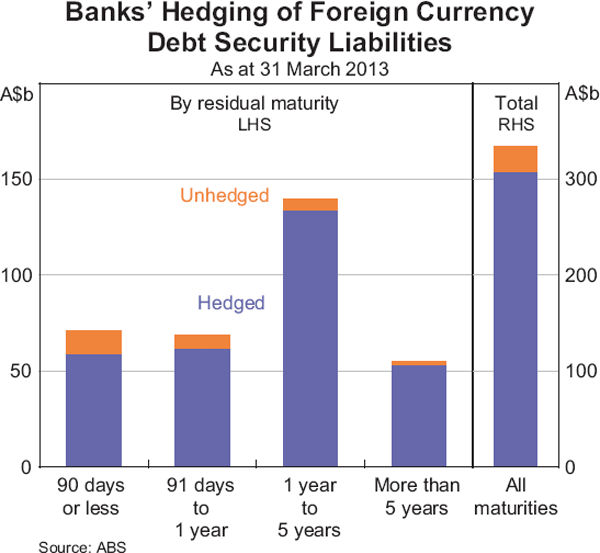
Other foreign currency debt liabilities – largely loans and deposits – account for the remainder of the banking sector's foreign currency liabilities. The FCE data suggest that around one-third of these liabilities were hedged using derivatives. However, the data also suggest that a sizeable share of the banking sector's other foreign currency debt liabilities had natural hedges, as the size and currency composition of its other foreign currency debt assets were closely matched to that of these liabilities.
Other financial corporations
The other financial corporations category covers a range of non-bank financial corporations, including superannuation and pension funds, insurance corporations and fund managers. These entities' foreign currency exposures generally arise from overseas investments, which are typically undertaken in an attempt to achieve higher risk-adjusted returns on their investment portfolios. In line with this, the FCE survey indicates that at the end of March 2013, this group of firms had a net foreign currency asset position equivalent to 22 per cent of GDP before taking into account the use of hedging derivatives, largely reflecting holdings of foreign equity assets. This net foreign currency asset position has risen modestly as a share of GDP since 2009 (from 18 per cent of GDP), owing to a reduction in these firms' foreign currency denominated debt liabilities over this period.
After accounting for the use of hedging derivatives, the FCE survey indicates that the overall net foreign currency asset position of other financial corporations was equivalent to 16 per cent of GDP, with a hedging ratio of around 35 per cent for foreign currency assets and 60 per cent for foreign currency liabilities (Table 1). The 2013 survey also suggests that hedging ratios for foreign equity assets were lower than those of foreign debt assets, which is also consistent with the results of the 2013 National Australia Bank Superannuation FX Survey (NAB Survey; NAB 2013).
The 2013 FCE survey results also suggest that the aggregate foreign currency asset hedging ratio for other financial corporations is likely to have declined over the four-year period (the 2009 results indicated that this group of firms usually hedged a little over 40 per cent of the value of their foreign currency assets) although this may in part reflect the timing of the surveys. In particular, the Australian dollar appreciated by around 40 per cent on a trade-weighted basis over the four-year period to be close to its post-float peak at the time of the 2013 survey, which may have increased some firms' expectations of future depreciation. The decline in the sector's hedging ratio is also broadly consistent with the results of the NAB Survey, which showed that hedging ratios for superannuation funds declined by 5–10 percentage points across most asset classes between 2011 and 2013. The NAB Survey suggests that fund managers have increasingly adopted a portfolio approach to managing their foreign currency risk, which involves accounting for correlations between exchange rates and underlying foreign currency asset prices in choosing an ‘optimal hedging ratio’ for the portfolio as a whole. This is in contrast to an asset-based approach, in which foreign currency risk is managed separately for each asset class. By accounting for natural hedges that may arise from correlations between movements in the price of different asset classes and/or exchange rates, a portfolio-based approach could be expected to result in lower derivatives-based hedging ratios than an asset-based approach.
Non-financial corporations
Non-financial corporations also had an overall net foreign currency asset position (before taking into account the use of hedging derivatives) equivalent to 7 per cent of GDP as at the end of March 2013 (Table 1). This net position in turn consisted of foreign currency asset holdings equivalent to about 20 per cent of GDP, with more than three-quarters of this in the form of equity investment (including direct investment by multinational companies in their offshore operations). In contrast to banks and other financial corporations, the non-financial sector's foreign currency liabilities have risen since 2009, consistent with an increase in borrowings in foreign debt markets by larger corporations (particularly in the mining sector).
The FCE survey indicates that around one-third of non-financial corporations' aggregate foreign currency liability exposures were hedged using derivatives, but only a negligible share of the sector's foreign currency assets were hedged using derivatives. As a result, non-financial corporations had a larger overall net foreign currency asset position, after taking into account the use of hedging derivatives. Although non-financial corporations' unhedged foreign currency assets accounted for 40 per cent of Australia's total unhedged foreign currency assets, these exposures represented less than 10 per cent of the sector's total assets. This suggests that, in aggregate, non-financial corporations' foreign currency assets and liabilities do not pose a large risk to the real economy.
The survey also suggests that there has been a reduction in the non-financial sector's hedging ratios for both assets and liabilities since 2009. Consistent with this, the notional amount of the sector's long Australian dollar (short foreign currency) derivative holdings more than halved over this period, while the notional amount of the sector's short Australian dollar (long foreign currency) derivatives fell modestly. As with the other financial corporations sector, the decline in the foreign currency asset hedging ratio may partly reflect expectations for the Australian dollar to depreciate, given that it was at a very high level at the time of the survey. The decrease in the liability hedging ratio could also reflect increased use of natural hedging; for example, firms with foreign currency payment obligations may have offsetting foreign currency receipts.
Public sector
The general government sector – which consists of national, state and local governments – had a net foreign currency asset position equivalent to around 3 per cent of GDP as at the end of March 2013, before taking into account the use of derivatives for hedging purposes (Table 2). The sector held foreign currency assets equivalent to about 4 per cent of GDP, with the majority of these likely to reflect investments by the Australian Government's Future Fund. Overall, the government sector is reported to have hedged about 70 per cent of its foreign currency asset exposure using derivatives.[13] The government sector had negligible foreign currency liabilities (equivalent to less than 1 per cent of GDP), which were mostly accounted for by liabilities of state borrowing authorities and were hedged almost entirely using derivatives.
| General Government | Reserve Bank of Australia | |||
|---|---|---|---|---|
| Before hedging | After hedging | Before hedging | After hedging | |
| A$ billion | ||||
| Assets | 65 | 19 | 39 | 39 |
| Liabilities | 13 | 0 | 0 | 0 |
| Net balance sheet exposure | 52 | 19 | 39 | 39 |
| Per cent of GDP | ||||
| Assets | 4 | 1 | 3 | 3 |
| Liabilities | 1 | 0 | 0 | 0 |
| Net balance sheet exposure | 3 | 1 | 3 | 3 |
|
Sources: ABS; RBA |
||||
As at the end of March 2013, the Reserve Bank had a foreign currency asset position of $39 billion, equivalent to 3 per cent of GDP, which was denominated in US dollars, euros, Japanese yen and Canadian dollars. This position consisted primarily of net reserves acquired on an outright basis, which are not hedged as these assets are held primarily to facilitate policy operations in the foreign exchange market. For this reason, the Bank holds the minimum level of reserves that it assesses will allow it to meet expected policy requirements.[14]
Summary
The Australian economy has historically been a net recipient of capital flows, which is reflected in its net foreign liability position. However, as most foreign liabilities are denominated in Australian dollars and the majority of foreign assets are denominated in foreign currencies, Australia has a net foreign currency asset position. This position increases in size after accounting for derivatives-based hedging. Australia's foreign currency asset position primarily reflects foreign equity holdings by non-bank financial corporations and the non-financial sector. The banking sector's foreign currency debt liabilities – and in particular its debt security liabilities – account for the bulk of Australia's foreign currency liabilities. At face value, this could raise concerns about the banking sector's ability to service these liabilities in the event of sudden depreciation of the Australian dollar. However, the FCE survey shows that the banking sector almost completely hedges its gross foreign currency debt security liability exposure using derivatives, and that the remaining foreign currency exposure is offset by natural hedges created by foreign currency asset holdings (e.g. payments and receipts generated by banks' offshore assets and liabilities with offsetting foreign currency risk). Overall, information from the 2013 FCE survey confirms that the use of foreign currency derivative contracts and the issuance of Australian dollar-denominated liabilities means that the Australian economy's net overall foreign liability position would not in itself be a source of vulnerability in the event of a sudden depreciation of the Australian dollar.
Footnotes
The authors are from International Department. [*]
For a discussion of the significance of Australia's floating exchange rate regime in allowing monetary policy to operate effectively and fostering real economic adjustment, see Stevens (2013). [1]
For a history of Australia's current account, see Belkar, Cockerell and Kent (2007). [2]
See ABS (2013b) for the primary source of this information. The results from the 2009 survey are discussed in D'Arcy, Shah Idil and Davis (2009). [3]
For non-financial firms, foreign currency exposures arising from expected trade payments and receipts are similar in size to, albeit less certain than, their foreign currency assets and liabilities (the equivalent of around 30 per cent of GDP). [4]
Also, the FCE survey does not necessarily capture the full extent of derivatives-based hedging by Australian entities. For example, if multinational companies with Australian operations manage their exposures centrally – rather than arranging hedging for their Australian subsidiary separately to other operations – these hedges will not be captured. [5]
The FCE survey indicates a slightly smaller net foreign currency asset position, as there are a number of small conceptual differences between the FCE survey and the IIP data. However, these differences do not materially affect the findings presented in this article. [6]
Examples of Australian dollar-denominated foreign assets include resident holdings of Australian dollar-denominated bonds issued by non-residents in the domestic market (‘Kangaroo’ bonds), Australian dollar-denominated loans made to non-residents by Australian banks and Australian banks' Australian dollar deposits with non-residents (including those related to intragroup funding transactions). [7]
While the 2009 FCE survey indicated a slightly higher net foreign currency asset position after taking into account the use of derivatives-based hedging (38 per cent of GDP), the data are not directly comparable owing to a number of survey design changes. In particular, the 2009 data were based on information collected about a sample of firms' usual hedging policies, whereas the 2013 data were based on information collected specifically about the actual use of derivatives for hedging purposes. [8]
Short-term liabilities are defined as those with a residual maturity of one year or less. [9]
A long position in a foreign currency derivative is one that would profit from a depreciation of the Australian dollar against that foreign currency. [10]
Cross-currency swaps involve the exchange of principal in different currencies as well as the payment of interest in one currency and the receipt of interest in another currency at a fixed exchange rate determined at the contract's initiation. See Arsov et al (2013) for more information. [11]
Offshore wholesale debt securities currently account for around 15 per cent of total banking sector liabilities. For more information about developments in the composition of Australian banks' funding, see RBA (2012). [12]
This is broadly in line with the level of hedging implied by the Future Fund's 2012/13 annual report (Future Fund 2013). [13]
For a discussion of the RBA's foreign exchange reserves, see Vallence (2012). [14]
References
ABS (Australian Bureau of Statistics) (2013a), ‘Balance of Payments and International Investment Position, Australia, March 2013’, ABS Cat No 5302.0, June.
ABS (2013b), ‘Foreign Currency Exposure, Australia, March 2013’, ABS Cat No 5308.0, October.
Arsov I, G Moran, B Shanahan and K Stacey (2013), ‘OTC Derivatives Reforms and the Australian Cross-currency Swap Market’, RBA Bulletin, June, pp 55–63.
Belkar R, L Cockerell and C Kent (2007), ‘Current Account Deficits: The Australian Debate’, RBA Research Discussion Paper 2007-02.
D'Arcy P, M Shah Idil and T Davis (2009), ‘Foreign Currency Exposure and Hedging in Australia’, RBA Bulletin, December, pp 1–10.
Future Fund (2013), Annual Report, 2012/2013, Future Fund Board of Guardians, Melbourne.
NAB (National Australia Bank) (2013), ‘Capturing the “Currency Effect”’, NAB Superannuation FX Survey 2013.
RBA (Reserve Bank of Australia) (2012), ‘Box A: Funding Composition of Banks in Australia’, Financial Stability Review, September, pp 33–36.
Stevens G (2013), ‘The Australian Dollar: Thirty Years of Floating’, Speech to the Australian Business Economists' Annual Dinner, Sydney, 21 November.
Vallence C (2012), ‘Foreign Exchange Reserves and the Reserve Bank's Balance Sheet’, RBA Bulletin, December, pp 57–63.